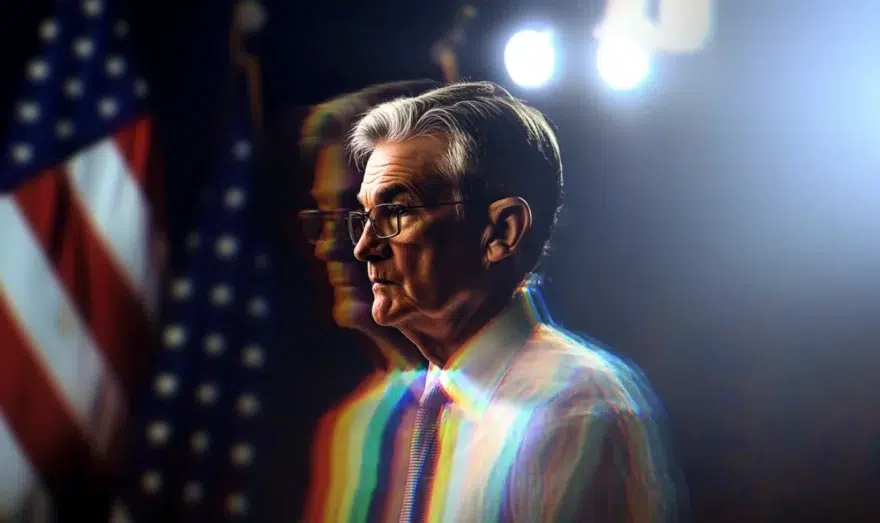The crypto boom of the decade? Bitcoin soars amid a perfect storm of global change — here’s what’s driving it

Why are investors feeling more optimistic than ever about Bitcoin? From sentiment indicators to market dynamics, here’s what’s sparking all the excitement.
Table of Contents
Historic highs and market dynamics
Bitcoin (BTC) is experiencing a remarkable resurgence after a prolonged period of volatility.
As of Nov. 12, BTC is trading near the $90,000 mark, currently around $87,000 levels. Earlier today, it reached a new all-time high of $89,900, reflecting a substantial 25% surge over the past week alone.
Notably, this bullish trend has propelled the total crypto market cap past the $3 trillion mark on Nov. 12, although it later stabilized at approximately $2.97 trillion.
Adding to the exuberance, the Fear and Greed Index—a tool that gauges investor sentiment—has climbed to an exceptionally high score of 86, indicating a phase of extreme greed, the highest since March 2024, when the index briefly hit 92, right before BTC’s previous record-breaking peak.
The current wave of optimism in the crypto market is particularly intertwined with political developments. With Donald Trump set to return to the White House, many in the crypto sector are hopeful for a regulatory environment that could be more favorable.
Trump’s victory brought with it promises of pro-crypto policies, aiming to reduce the regulatory hurdles that have kept many crypto businesses on uncertain ground.
With all these factors in play, where could the market head next? Let’s dig into the data and indicators driving this historic crypto moment and see what clues they offer about the road ahead.
Trump’s crypto promises in focus
Donald Trump’s return to the Oval Office signals a key shift for the U.S. crypto landscape, surprising those who remember his previously critical stance on digital assets.
Historically, Trump was vocal in his disapproval of cryptocurrencies, labeling Bitcoin a “scam” and cautioning that it threatened the dollar’s global dominance.
However, in the lead-up to the 2024 election, his stance evolved substantially. Now, he not only embraces crypto but appears poised to position it as a fundamental component of his economic agenda.
Throughout his campaign, Trump expressed support for crypto and committed to reducing regulatory barriers—a position echoed by his Republican allies in the Senate.
He even proposed establishing a “strategic Bitcoin reserve,” suggesting that Bitcoin seized from criminal activities should be retained by the government rather than auctioned off.
This concept, initially advocated by Senator Cynthia Lummis, has generated interest as a means to position Bitcoin as a national asset, potentially providing a hedge against inflation and national debt.
Trump’s plans extend beyond merely holding Bitcoin; he has also outlined intentions to reshape the U.S. Securities and Exchange Commission, an agency that has long been at odds with the crypto industry.
He has pledged to replace the current SEC chair, Gary Gensler, known for his stringent regulatory stance, which resulted in over 100 enforcement actions against crypto companies.
Industry advocates argue that these companies require regulatory clarity over punitive measures, and Trump’s approach could represent a departure toward more industry-aligned guidance.
Further, Trump has articulated ambitions for the U.S. to lead in Bitcoin mining, aiming to shift dominance from countries like Kazakhstan and Russia. His vision includes transforming the U.S. into a “Bitcoin mining hub” and promoting Bitcoin as a product that should be “Made in the USA.”
In another notable commitment, Trump has vowed to protect Americans’ right to self-custody—a foundational crypto principle that allows individuals to independently manage their assets.
He also aims to block any attempts to establish a central bank digital currency in the U.S., citing concerns that such a currency could undermine financial privacy.
To guide these initiatives, Trump has proposed establishing a “crypto advisory council,” bringing together industry experts and crypto community leaders to help shape policies that encourage growth rather than restriction.
If these plans come to fruition, they could position the U.S. as a global leader in crypto-friendly policy, fostering innovation and attracting investment across the industry.
The Federal Reserve’s influence
On Nov. 7, the Federal Reserve reduced its benchmark overnight borrowing rate by 25 basis points, adjusting it to a target range of 4.50% to 4.75%.
Although this cut is smaller than the half-point reduction in September, it indicates a continued shift toward a more cautious approach in managing inflation while aiming to sustain a robust labor market.
The policy adjustment reflects the Fed’s evolving view as inflation trends closer to its 2% target, accompanied by subtle signs of cooling in the labor market.
Notably, the Fed’s latest statement now indicates that “risks to achieving its employment and inflation goals are roughly in balance,” a softer stance compared to its September language, which suggested a more urgent focus on inflation control.
Rate cuts have historically impacted crypto prices. By lowering interest rates, the Fed aims to stimulate economic activity, encouraging both consumers and businesses to borrow, invest, and spend more.
According to the CME FedWatch Tool, there is currently over a 65% likelihood of another 25-basis-point cut in December, which would further lower rates.
Analysts, including Charlie Bilello, foresee additional rate cuts into 2025, with projections suggesting a potential range of 3.75% to 4% by June 2025.
For the crypto market, such a trend toward lower rates can often drive asset prices higher, as cheaper borrowing costs make higher-risk investments, like cryptocurrencies, more appealing to investors seeking potentially greater returns.
Global central banks join the rate-cutting party
It’s not just the U.S. that’s lowering interest rates. Central banks across the globe have been stepping in to ease monetary policies, a trend that’s sweeping through economies from Asia to South America.
Countries like Hong Kong and Saudi Arabia recently followed the Fed’s lead, each cutting their rates by 25 basis points, bringing their respective rates to 5.00% and 5.25%.
Even Peru, which has been especially proactive, just made its 11th rate cut, trimming rates down to 5.00%.
According to data from Bilello, out of 31 major countries, only nine have chosen to raise interest rates since February 2023. The vast majority have leaned into rate cuts, joining the global movement to make borrowing cheaper and encourage spending and investment.
Even the Eurozone, which has been cautious about rate cuts, has shifted toward a more accommodative stance, mirroring the U.S. in its approach to economic support.
For the crypto market, this wave of global rate cuts could have interesting effects. When borrowing costs are low worldwide, it can lead to a flow of capital into high-yield assets like cryptocurrencies.
Furthermore, as rates drop in more countries, the weakening of various fiat currencies could also lead to stronger demand for “digital stores of value” like Bitcoin.
Global liquidity rises, but fragility remains
The crypto market, along with other risk-on assets, is currently riding a wave of enthusiasm, though the underlying drivers of this rally are complex and, in some respects, fragile.
A key factor fueling this momentum is global liquidity—the overall money supply circulating in the economy. As of Nov. 12, global liquidity has risen by 4.37% this week alone, raising the global liquidity index to $131.263 trillion from $125.764 trillion the previous week.
The liquidity surge has helped boost bullish sentiment, especially in assets like Bitcoin, which is highly responsive to changes in global money flow. However, this increase in liquidity is somewhat precarious, primarily supported by what’s known as the “collateral multiplier.”
Essentially, this multiplier indicates how much banks can lend based on the assets they hold as collateral. When the multiplier strengthens, banks can lend more, temporarily boosting liquidity.
But this is not the same as a fundamental improvement in economic health; rather, it’s a short-term measure that props up financial conditions — like scaffolding around a structure that may lack enduring stability.
A potential risk factor lies in China, where credit growth, including bank loans and other forms of liquidity, has been slowing. In October, bank lending was weaker than expected, and liquidity showed a declining trend.
As one of the world’s largest economies, any slowdown in China’s liquidity can ripple across global markets, signaling possible challenges ahead.
Without strong credit growth in China, sustaining global liquidity at current levels could become difficult, potentially undermining investor confidence.
Adding another layer to this scenario is the measured approach being taken by central banks. While interest rates are declining in many regions, central banks are refraining from aggressively injecting liquidity into the economy as they have in past years.
This restrained approach means there’s no guarantee of sustained liquidity levels, which could create headwinds for high-risk assets like cryptocurrencies if liquidity tapers off.
This situation echoes last year, when market speculation fueled price increases, with liquidity arriving “just in time” to maintain momentum. Currently, investors are looking to Q4 for further liquidity inflows, speculating that any dips could present buying opportunities before the next potential surge.
Bitcoin’s historical cycles and the path forward
As we look ahead to the next few weeks, several indicators suggest that the crypto market — and Bitcoin in particular — could face both opportunities and challenges.
Historically, Bitcoin’s journey into “price discovery” — the period when it surpasses previous highs and explores uncharted territory — has seen early rallies followed by corrections.
Looking back, the 2017 bull cycle showed BTC rallying for about 8 weeks before facing a deeper pullback, while the 2020/2021 cycle saw a correction after 4 weeks of upward movement.
According to Rekt Capital, “It’s only Week 1 right now,” which means Bitcoin might still have a strong upward run before we see any substantial correction.
Still, it’s wise to stay cautious and not assume the climb will be uninterrupted. Cycles like this tend to bring excitement, but history shows us that pullbacks are part of the journey.
Another potential bump in the road may come from macroeconomic data. This week, all eyes are on the U.S. Consumer Price Index report, a key inflation gauge, expected to show a slight increase in headline inflation to 2.6% from 2.4%, while core inflation may hold steady at 3.3%.
Any signs that inflation is heating up could influence the Federal Reserve’s stance on rate cuts. A surprising uptick might lead the Fed to reconsider the pace of easing, especially since markets are heavily betting on a 25 bps cut in December.
If inflation surprises to the upside, however, it might challenge the Fed’s room to cut rates, which could strengthen the U.S. dollar and potentially weigh on risk assets like Bitcoin.
Michaël van de Poppe suggests that “a 10% correction toward the CME gap” could occur, especially if inflation data comes in hotter than expected.
Another factor influencing Bitcoin is the rising popularity of Bitcoin exchange-traded funds. As of Nov. 12, Bitcoin ETFs hold over $90 billion in assets, marking a huge milestone.
This figure has jumped by $6 billion in just a single day, with $1 billion from new inflows and $5 billion from appreciation in Bitcoin’s price. Bitcoin ETFs are now 72% of the way to surpassing gold ETFs in assets.
Lastly, some analysts are concerned that Trump’s policy proposals could increase inflationary pressures over time. If inflation picks up by 2025, it may limit the Fed’s ability to continue with aggressive rate cuts.
This means that while the short-term environment could favor crypto investments, the longer-term outlook will depend heavily on how inflation evolves and how the Fed responds.
In conclusion, with inflation risks looming and the Fed’s rate path uncertain, this is a period for careful monitoring rather than unchecked enthusiasm. Trade wisely and never invest more than you can afford to lose.
Disclosure: This article does not represent investment advice. The content and materials featured on this page are for educational purposes only.















